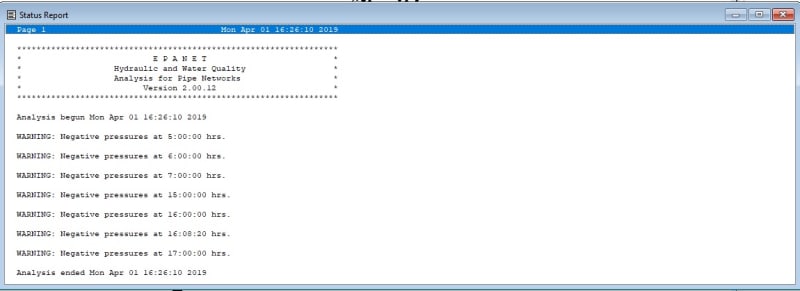Ellie60…
I found the following problems:
-- In the new model you posted, Pattern 1 (which determines how the base demands are factored up or down for each time slice) shows a multiplier of zero across the board. This makes all node demands zero and we are left with flows running straight from the two higher reservoirs (22 in the bigger system and 32 in the smaller system) to the two lower reservoirs (34 and 33, respectively). On the other hand, this condition produced velocities ranging from about 3.3 fps to about 6.4 fps, which is reasonable even if it's a fictitious situation.
![[smile] [smile] [smile]](/data/assets/smilies/smile.gif)
-- When I edited Pattern 1 to use a multiplier of 1.0 for the first time slice, I landed back at the same problem you mentioned: extreme velocities and negative pressures.
Fortunately, you renamed the nodes (not as I suggested, but your method is OK too), so I was able to figure out what the real problem is. Well, two problems, actually.
-- All fire hydrants are flowing at the same time, which is unrealistic. The standard of practice is to run one fire flow at a time.
-- Four of the building demands are still far too large for the pipe sizes you are using and probably too large for the buildings themselves: 4,125 gpm at Bldg A-F, Bldg B-F, and Bldg C-F and 2,625 gpm at Storage F. I suspect errors in the method used to estimate building demands.
Solutions:
-- Consider which demand levels you need to run. For most systems, the critical high flow scenarios are [1] Peak Hour Demand (PHD) and [2] Maximum Day Demand Plus Fire Flow (MDD+FF). For some municipal systems, a minimum winter-time flow scenario is also required to deal with water quality issues stemming from low flow conditions. Some systems can have other specific requirements. When I set up a model for situations like yours, I use the Average Day Demand (ADD) for my base demand. Then, assuming I am not running a true time period simulation, I usually set the demand factor for the first time slice to 1.0 (ADD/ADD =1.0), the second demand factor equal to PHD/ADD (in my experience, this is usually in the 3.0-4.0 range, but it can be smaller, larger, or much larger). All remaining time slices I reserve for however many MDD+FF scenarios I need to run (see following bullet).
-- If your fire flow requirement is 1500 gpm, you may want to split it so that 1000 gpm is at one hydrant and the remaining 500 gpm is at the next nearest hydrant. This is a common procedure that I have discussed several times over the years here. You may find these discussions useful:
and
and
Here is some additional guidance I provided a few years abo about EPANET that includes more information about fire flows:
It's a LONG thread, but there are a lot of good nuggets in there. If you want to test fire flows at multiple locations, then it's simply a matter of using multiple demand patterns to adjust flows between zero and your base fire flow (or, for the split I suggest, then using factors of 0.66 and 0.33 against a base fire flow demand of 1,500 gpm). In this case, you are running a time period simulation, but where time is irrelevant. The time slices are there to separate different fire flow locations.
-- You may want to evaluate building peak demands using the Fixture Unit Method, if your plumbing code uses it. Here are two discussions about it:
and
Eng-Tips has a couple dozen threads about the Fixture Unit Method.
I hope this helps. If you need more guidance, just let me know.
Fred
==========
"Is it the only lesson of history that mankind is unteachable?"
--Winston S. Churchill



![[smile] [smile] [smile]](/data/assets/smilies/smile.gif)
![[mad] [mad] [mad]](/data/assets/smilies/mad.gif)